Management Accounting Report: Unit 5, MR College, Semester 1
VerifiedAdded on 2023/01/18
|16
|2938
|63
Report
AI Summary
This report provides a comprehensive analysis of management accounting principles. Task 1 explores marginal and absorption costing, detailing their differences, applications, and impact on profit/loss figures. Task 2 delves into budgetary control, examining various planning tools like fixed, flexible, incremental, and zero-based budgets, along with variance analysis. The report evaluates the advantages and disadvantages of these tools, and analyzes their application in preparing and forecasting budgets. Furthermore, the report discusses how organizations like Tesco and Sainsbury use management accounting to address financial issues, incorporating both financial and non-financial performance indicators. The report concludes by evaluating how management accounting helps organizations respond to financial problems and achieve sustainable success, including the integration of sustainable practices and the use of management accounting tools.

Running head: MANAGEMENT ACCOUNTING
Management Accounting
Name of the Student:
Name of the University:
Author’s Note:
Course ID:
Management Accounting
Name of the Student:
Name of the University:
Author’s Note:
Course ID:
Paraphrase This Document
Need a fresh take? Get an instant paraphrase of this document with our AI Paraphraser
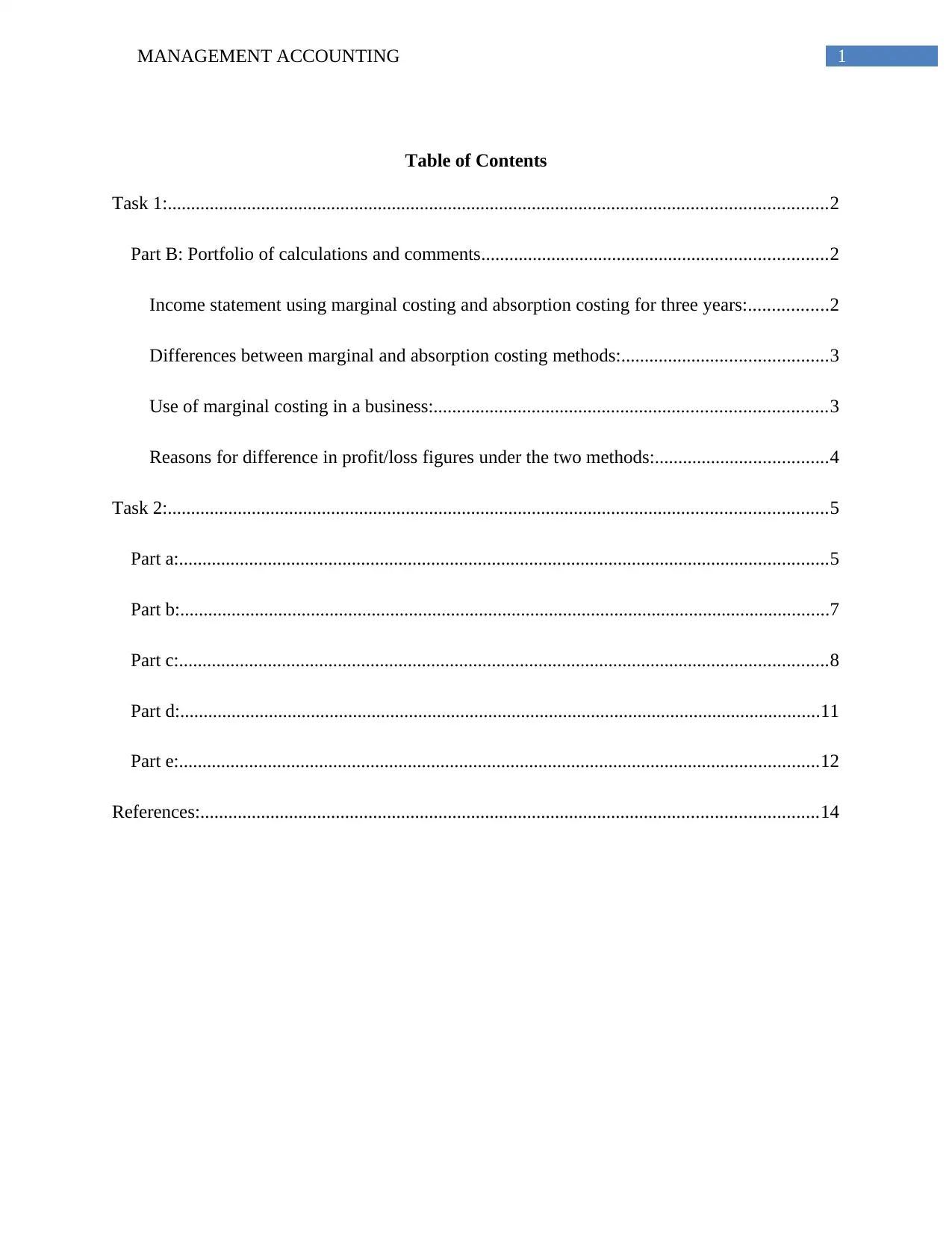
1MANAGEMENT ACCOUNTING
Table of Contents
Task 1:.............................................................................................................................................2
Part B: Portfolio of calculations and comments..........................................................................2
Income statement using marginal costing and absorption costing for three years:.................2
Differences between marginal and absorption costing methods:............................................3
Use of marginal costing in a business:....................................................................................3
Reasons for difference in profit/loss figures under the two methods:.....................................4
Task 2:.............................................................................................................................................5
Part a:...........................................................................................................................................5
Part b:...........................................................................................................................................7
Part c:...........................................................................................................................................8
Part d:.........................................................................................................................................11
Part e:.........................................................................................................................................12
References:....................................................................................................................................14
Table of Contents
Task 1:.............................................................................................................................................2
Part B: Portfolio of calculations and comments..........................................................................2
Income statement using marginal costing and absorption costing for three years:.................2
Differences between marginal and absorption costing methods:............................................3
Use of marginal costing in a business:....................................................................................3
Reasons for difference in profit/loss figures under the two methods:.....................................4
Task 2:.............................................................................................................................................5
Part a:...........................................................................................................................................5
Part b:...........................................................................................................................................7
Part c:...........................................................................................................................................8
Part d:.........................................................................................................................................11
Part e:.........................................................................................................................................12
References:....................................................................................................................................14

2MANAGEMENT ACCOUNTING
Task 1:
Part B: Portfolio of calculations and comments
Income statement using marginal costing and absorption costing for three years:
From the above table, it could be seen that the difference in net income in the two costing
methods is owing to the difference in stock. The net income of the organisation in the initial two
years is higher under absorption costing than marginal costing, while the situation has changed in
the third year. This is because in absorption costing, fixed production overhead is charged to
product cost. On the other hand, in case of marginal costing, the same is taken into account in the
form of period costs.
Task 1:
Part B: Portfolio of calculations and comments
Income statement using marginal costing and absorption costing for three years:
From the above table, it could be seen that the difference in net income in the two costing
methods is owing to the difference in stock. The net income of the organisation in the initial two
years is higher under absorption costing than marginal costing, while the situation has changed in
the third year. This is because in absorption costing, fixed production overhead is charged to
product cost. On the other hand, in case of marginal costing, the same is taken into account in the
form of period costs.
⊘ This is a preview!⊘
Do you want full access?
Subscribe today to unlock all pages.

Trusted by 1+ million students worldwide

3MANAGEMENT ACCOUNTING
Differences between marginal and absorption costing methods:
Basis for comparison Marginal costing Absorption costing
Meaning Technique of decision-making
to determine total production
cost
Allocation of total costs to the
cost centre for ascertaining the
total production cost
Cost recognition Variable cost is taken into
account as product cost, while
fixed cost is classified as
period cost (Alsharari, Dixon
and Youssef 2015).
Both variable and fixed costs
are taken into account as
period costs.
Overhead classification Variable and fixed Administrative, production,
selling and distribution
Profitability This is gauged by profit
volume ratio.
By including fixed cost, there
is impact on fixed cost.
Highlights Contribution per unit Net income per unit
Cost data Presented to depict overall
contribution of each product
Depicted in a conventional
manner (Boučková 2015)
Use of marginal costing in a business:
In any business organisation, marginal costing is used for the following purposes:
Cost determination:
Differences between marginal and absorption costing methods:
Basis for comparison Marginal costing Absorption costing
Meaning Technique of decision-making
to determine total production
cost
Allocation of total costs to the
cost centre for ascertaining the
total production cost
Cost recognition Variable cost is taken into
account as product cost, while
fixed cost is classified as
period cost (Alsharari, Dixon
and Youssef 2015).
Both variable and fixed costs
are taken into account as
period costs.
Overhead classification Variable and fixed Administrative, production,
selling and distribution
Profitability This is gauged by profit
volume ratio.
By including fixed cost, there
is impact on fixed cost.
Highlights Contribution per unit Net income per unit
Cost data Presented to depict overall
contribution of each product
Depicted in a conventional
manner (Boučková 2015)
Use of marginal costing in a business:
In any business organisation, marginal costing is used for the following purposes:
Cost determination:
Paraphrase This Document
Need a fresh take? Get an instant paraphrase of this document with our AI Paraphraser
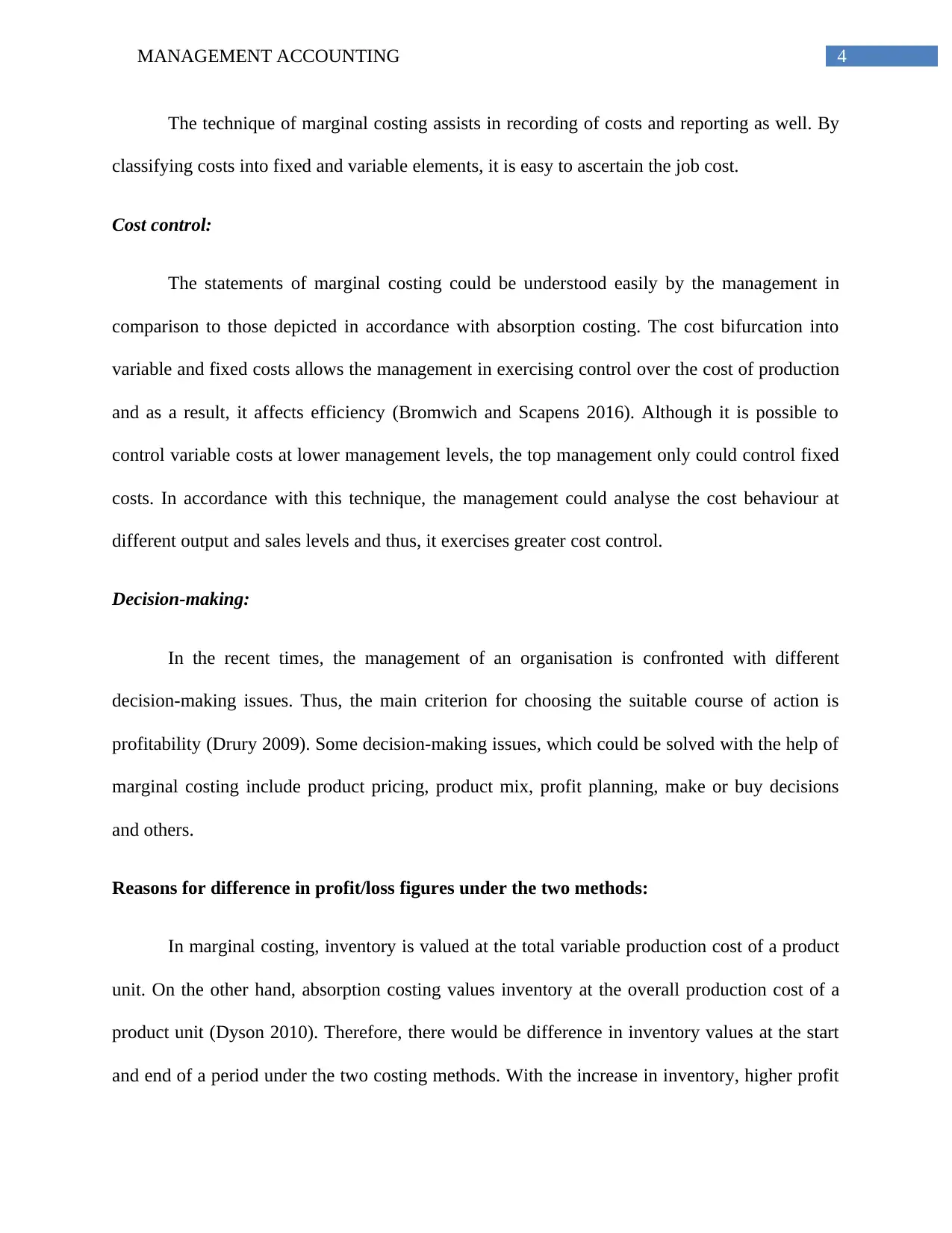
4MANAGEMENT ACCOUNTING
The technique of marginal costing assists in recording of costs and reporting as well. By
classifying costs into fixed and variable elements, it is easy to ascertain the job cost.
Cost control:
The statements of marginal costing could be understood easily by the management in
comparison to those depicted in accordance with absorption costing. The cost bifurcation into
variable and fixed costs allows the management in exercising control over the cost of production
and as a result, it affects efficiency (Bromwich and Scapens 2016). Although it is possible to
control variable costs at lower management levels, the top management only could control fixed
costs. In accordance with this technique, the management could analyse the cost behaviour at
different output and sales levels and thus, it exercises greater cost control.
Decision-making:
In the recent times, the management of an organisation is confronted with different
decision-making issues. Thus, the main criterion for choosing the suitable course of action is
profitability (Drury 2009). Some decision-making issues, which could be solved with the help of
marginal costing include product pricing, product mix, profit planning, make or buy decisions
and others.
Reasons for difference in profit/loss figures under the two methods:
In marginal costing, inventory is valued at the total variable production cost of a product
unit. On the other hand, absorption costing values inventory at the overall production cost of a
product unit (Dyson 2010). Therefore, there would be difference in inventory values at the start
and end of a period under the two costing methods. With the increase in inventory, higher profit
The technique of marginal costing assists in recording of costs and reporting as well. By
classifying costs into fixed and variable elements, it is easy to ascertain the job cost.
Cost control:
The statements of marginal costing could be understood easily by the management in
comparison to those depicted in accordance with absorption costing. The cost bifurcation into
variable and fixed costs allows the management in exercising control over the cost of production
and as a result, it affects efficiency (Bromwich and Scapens 2016). Although it is possible to
control variable costs at lower management levels, the top management only could control fixed
costs. In accordance with this technique, the management could analyse the cost behaviour at
different output and sales levels and thus, it exercises greater cost control.
Decision-making:
In the recent times, the management of an organisation is confronted with different
decision-making issues. Thus, the main criterion for choosing the suitable course of action is
profitability (Drury 2009). Some decision-making issues, which could be solved with the help of
marginal costing include product pricing, product mix, profit planning, make or buy decisions
and others.
Reasons for difference in profit/loss figures under the two methods:
In marginal costing, inventory is valued at the total variable production cost of a product
unit. On the other hand, absorption costing values inventory at the overall production cost of a
product unit (Dyson 2010). Therefore, there would be difference in inventory values at the start
and end of a period under the two costing methods. With the increase in inventory, higher profit
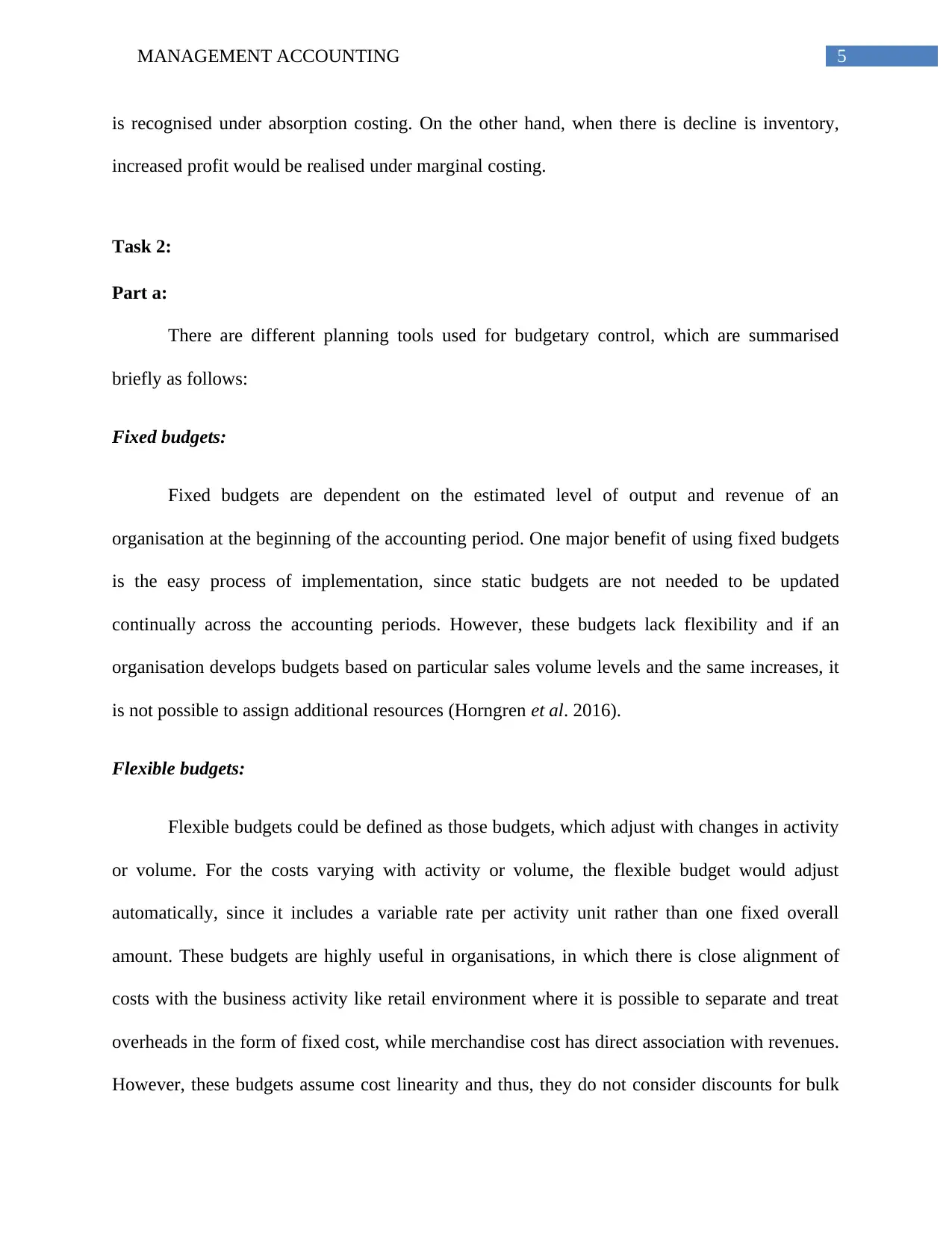
5MANAGEMENT ACCOUNTING
is recognised under absorption costing. On the other hand, when there is decline is inventory,
increased profit would be realised under marginal costing.
Task 2:
Part a:
There are different planning tools used for budgetary control, which are summarised
briefly as follows:
Fixed budgets:
Fixed budgets are dependent on the estimated level of output and revenue of an
organisation at the beginning of the accounting period. One major benefit of using fixed budgets
is the easy process of implementation, since static budgets are not needed to be updated
continually across the accounting periods. However, these budgets lack flexibility and if an
organisation develops budgets based on particular sales volume levels and the same increases, it
is not possible to assign additional resources (Horngren et al. 2016).
Flexible budgets:
Flexible budgets could be defined as those budgets, which adjust with changes in activity
or volume. For the costs varying with activity or volume, the flexible budget would adjust
automatically, since it includes a variable rate per activity unit rather than one fixed overall
amount. These budgets are highly useful in organisations, in which there is close alignment of
costs with the business activity like retail environment where it is possible to separate and treat
overheads in the form of fixed cost, while merchandise cost has direct association with revenues.
However, these budgets assume cost linearity and thus, they do not consider discounts for bulk
is recognised under absorption costing. On the other hand, when there is decline is inventory,
increased profit would be realised under marginal costing.
Task 2:
Part a:
There are different planning tools used for budgetary control, which are summarised
briefly as follows:
Fixed budgets:
Fixed budgets are dependent on the estimated level of output and revenue of an
organisation at the beginning of the accounting period. One major benefit of using fixed budgets
is the easy process of implementation, since static budgets are not needed to be updated
continually across the accounting periods. However, these budgets lack flexibility and if an
organisation develops budgets based on particular sales volume levels and the same increases, it
is not possible to assign additional resources (Horngren et al. 2016).
Flexible budgets:
Flexible budgets could be defined as those budgets, which adjust with changes in activity
or volume. For the costs varying with activity or volume, the flexible budget would adjust
automatically, since it includes a variable rate per activity unit rather than one fixed overall
amount. These budgets are highly useful in organisations, in which there is close alignment of
costs with the business activity like retail environment where it is possible to separate and treat
overheads in the form of fixed cost, while merchandise cost has direct association with revenues.
However, these budgets assume cost linearity and thus, they do not consider discounts for bulk
⊘ This is a preview!⊘
Do you want full access?
Subscribe today to unlock all pages.

Trusted by 1+ million students worldwide
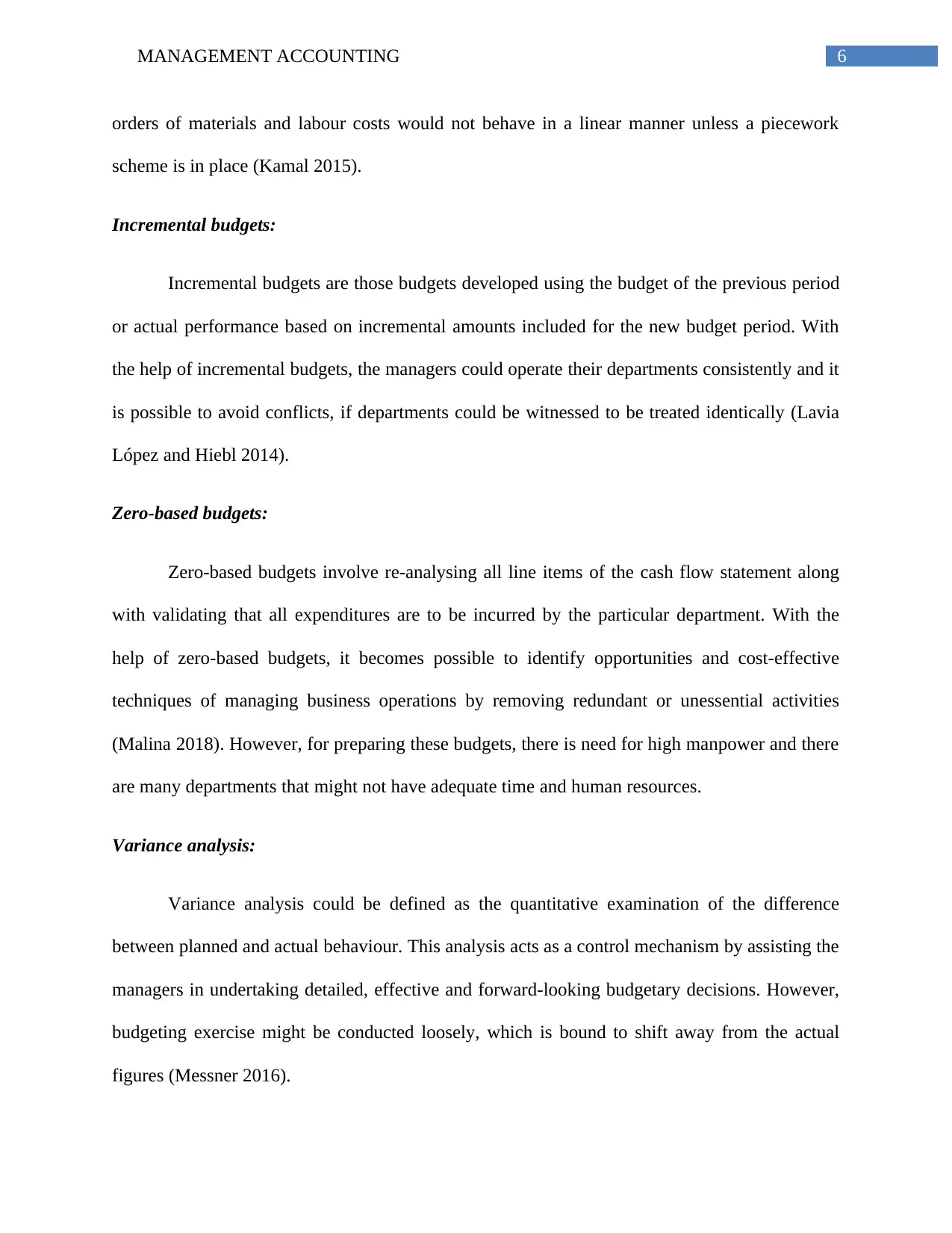
6MANAGEMENT ACCOUNTING
orders of materials and labour costs would not behave in a linear manner unless a piecework
scheme is in place (Kamal 2015).
Incremental budgets:
Incremental budgets are those budgets developed using the budget of the previous period
or actual performance based on incremental amounts included for the new budget period. With
the help of incremental budgets, the managers could operate their departments consistently and it
is possible to avoid conflicts, if departments could be witnessed to be treated identically (Lavia
López and Hiebl 2014).
Zero-based budgets:
Zero-based budgets involve re-analysing all line items of the cash flow statement along
with validating that all expenditures are to be incurred by the particular department. With the
help of zero-based budgets, it becomes possible to identify opportunities and cost-effective
techniques of managing business operations by removing redundant or unessential activities
(Malina 2018). However, for preparing these budgets, there is need for high manpower and there
are many departments that might not have adequate time and human resources.
Variance analysis:
Variance analysis could be defined as the quantitative examination of the difference
between planned and actual behaviour. This analysis acts as a control mechanism by assisting the
managers in undertaking detailed, effective and forward-looking budgetary decisions. However,
budgeting exercise might be conducted loosely, which is bound to shift away from the actual
figures (Messner 2016).
orders of materials and labour costs would not behave in a linear manner unless a piecework
scheme is in place (Kamal 2015).
Incremental budgets:
Incremental budgets are those budgets developed using the budget of the previous period
or actual performance based on incremental amounts included for the new budget period. With
the help of incremental budgets, the managers could operate their departments consistently and it
is possible to avoid conflicts, if departments could be witnessed to be treated identically (Lavia
López and Hiebl 2014).
Zero-based budgets:
Zero-based budgets involve re-analysing all line items of the cash flow statement along
with validating that all expenditures are to be incurred by the particular department. With the
help of zero-based budgets, it becomes possible to identify opportunities and cost-effective
techniques of managing business operations by removing redundant or unessential activities
(Malina 2018). However, for preparing these budgets, there is need for high manpower and there
are many departments that might not have adequate time and human resources.
Variance analysis:
Variance analysis could be defined as the quantitative examination of the difference
between planned and actual behaviour. This analysis acts as a control mechanism by assisting the
managers in undertaking detailed, effective and forward-looking budgetary decisions. However,
budgeting exercise might be conducted loosely, which is bound to shift away from the actual
figures (Messner 2016).
Paraphrase This Document
Need a fresh take? Get an instant paraphrase of this document with our AI Paraphraser

7MANAGEMENT ACCOUNTING
Part b:
By using fixed budget, it is possible to conduct variance analysis through which an
organisation could determine whether the budget is below or it has exceeded the original
estimations with the help of percentage and pounds. Thus, it is easy to plan for future years when
there is a comparison between the expected and the actual results (Nielsen, Mitchell and
Nørreklit 2015). In future, it is possible to adjust the budget down or up based on variance
percentages.
Flexible budget could be utilised more easily for updating a budget for which no
finalisation has been made on revenue or other activity figures. In this approach, the managers
provide the approval for all fixed costs and variable costs as part of revenues or other activity
measures. After this, the budgeting staffs finish the remaining part of the budget that flows
through formulas in flexible budget and expense levels are altered automatically.
Incremental budget is suitable to use, if the main cost drivers do not vary from year to
year. In this type of budget, the figures of each income and expense have started with the actual
numbers of the previous years and they are adjusted for inflation, growth in market and other
necessary factors. Thus, the previous year’s budget could be used as a benchmark after which the
management could add incremental amounts to the upcoming budget period (Otley 2016).
With the help of zero-based budgeting, higher-level strategic objectives could be
implemented into the budget process by tying them to particular functional areas of the firm, in
which it is possible to group costs initially, after which they could be gauged against past
outcomes and existing expectations. Thus, it assists in minimising costs by avoiding blanket rise
or fall in the budget of the prior period.
Part b:
By using fixed budget, it is possible to conduct variance analysis through which an
organisation could determine whether the budget is below or it has exceeded the original
estimations with the help of percentage and pounds. Thus, it is easy to plan for future years when
there is a comparison between the expected and the actual results (Nielsen, Mitchell and
Nørreklit 2015). In future, it is possible to adjust the budget down or up based on variance
percentages.
Flexible budget could be utilised more easily for updating a budget for which no
finalisation has been made on revenue or other activity figures. In this approach, the managers
provide the approval for all fixed costs and variable costs as part of revenues or other activity
measures. After this, the budgeting staffs finish the remaining part of the budget that flows
through formulas in flexible budget and expense levels are altered automatically.
Incremental budget is suitable to use, if the main cost drivers do not vary from year to
year. In this type of budget, the figures of each income and expense have started with the actual
numbers of the previous years and they are adjusted for inflation, growth in market and other
necessary factors. Thus, the previous year’s budget could be used as a benchmark after which the
management could add incremental amounts to the upcoming budget period (Otley 2016).
With the help of zero-based budgeting, higher-level strategic objectives could be
implemented into the budget process by tying them to particular functional areas of the firm, in
which it is possible to group costs initially, after which they could be gauged against past
outcomes and existing expectations. Thus, it assists in minimising costs by avoiding blanket rise
or fall in the budget of the prior period.
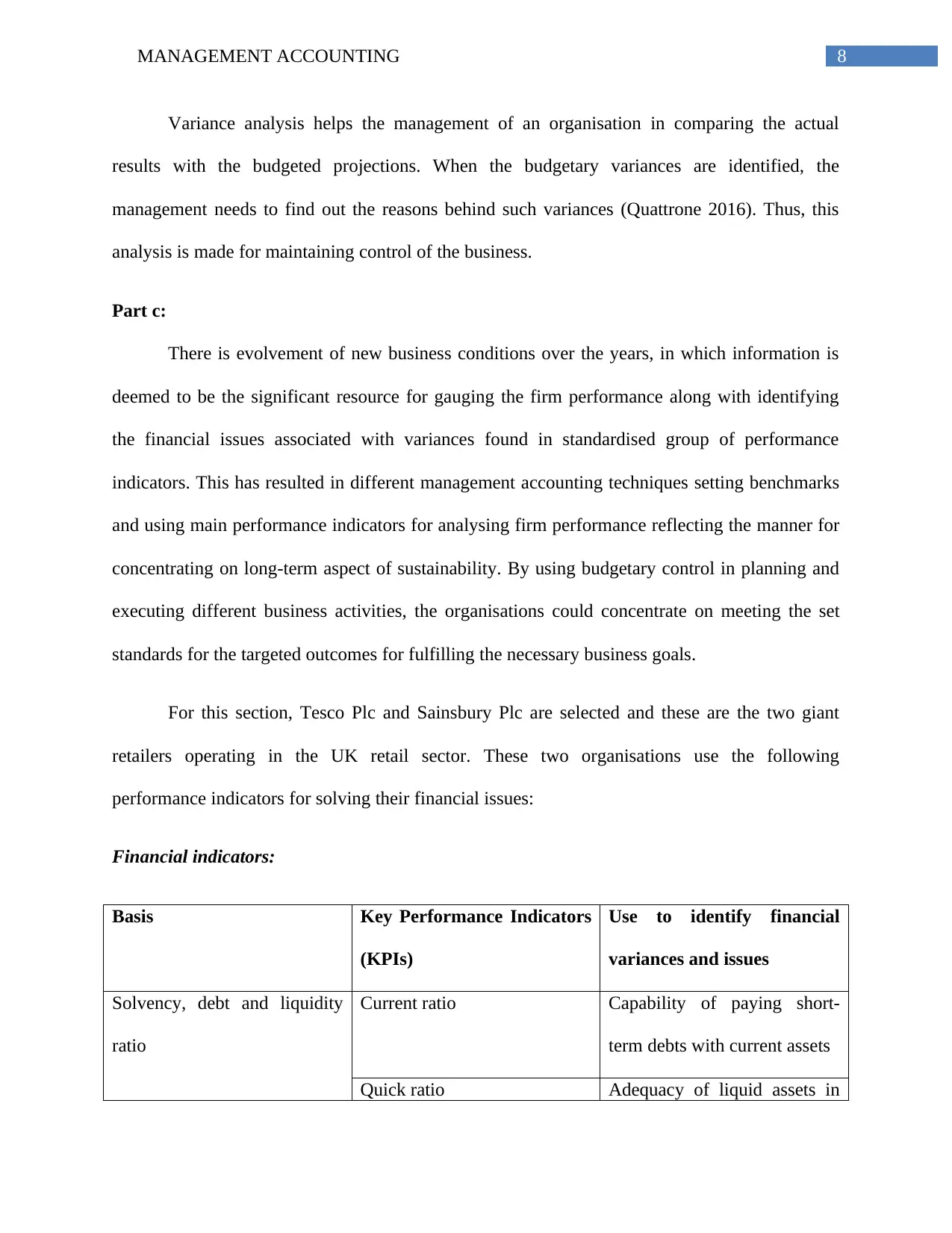
8MANAGEMENT ACCOUNTING
Variance analysis helps the management of an organisation in comparing the actual
results with the budgeted projections. When the budgetary variances are identified, the
management needs to find out the reasons behind such variances (Quattrone 2016). Thus, this
analysis is made for maintaining control of the business.
Part c:
There is evolvement of new business conditions over the years, in which information is
deemed to be the significant resource for gauging the firm performance along with identifying
the financial issues associated with variances found in standardised group of performance
indicators. This has resulted in different management accounting techniques setting benchmarks
and using main performance indicators for analysing firm performance reflecting the manner for
concentrating on long-term aspect of sustainability. By using budgetary control in planning and
executing different business activities, the organisations could concentrate on meeting the set
standards for the targeted outcomes for fulfilling the necessary business goals.
For this section, Tesco Plc and Sainsbury Plc are selected and these are the two giant
retailers operating in the UK retail sector. These two organisations use the following
performance indicators for solving their financial issues:
Financial indicators:
Basis Key Performance Indicators
(KPIs)
Use to identify financial
variances and issues
Solvency, debt and liquidity
ratio
Current ratio Capability of paying short-
term debts with current assets
Quick ratio Adequacy of liquid assets in
Variance analysis helps the management of an organisation in comparing the actual
results with the budgeted projections. When the budgetary variances are identified, the
management needs to find out the reasons behind such variances (Quattrone 2016). Thus, this
analysis is made for maintaining control of the business.
Part c:
There is evolvement of new business conditions over the years, in which information is
deemed to be the significant resource for gauging the firm performance along with identifying
the financial issues associated with variances found in standardised group of performance
indicators. This has resulted in different management accounting techniques setting benchmarks
and using main performance indicators for analysing firm performance reflecting the manner for
concentrating on long-term aspect of sustainability. By using budgetary control in planning and
executing different business activities, the organisations could concentrate on meeting the set
standards for the targeted outcomes for fulfilling the necessary business goals.
For this section, Tesco Plc and Sainsbury Plc are selected and these are the two giant
retailers operating in the UK retail sector. These two organisations use the following
performance indicators for solving their financial issues:
Financial indicators:
Basis Key Performance Indicators
(KPIs)
Use to identify financial
variances and issues
Solvency, debt and liquidity
ratio
Current ratio Capability of paying short-
term debts with current assets
Quick ratio Adequacy of liquid assets in
⊘ This is a preview!⊘
Do you want full access?
Subscribe today to unlock all pages.

Trusted by 1+ million students worldwide
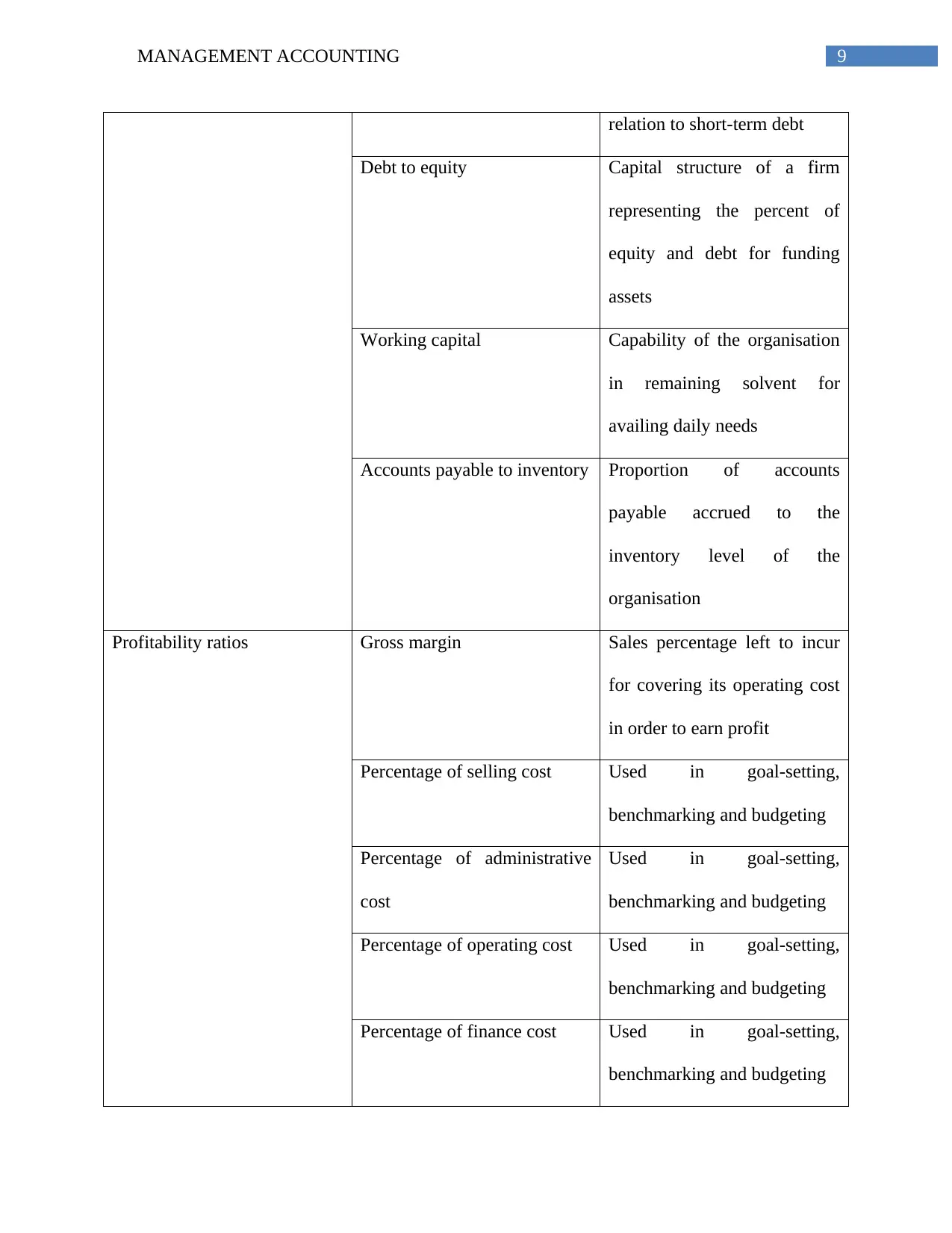
9MANAGEMENT ACCOUNTING
relation to short-term debt
Debt to equity Capital structure of a firm
representing the percent of
equity and debt for funding
assets
Working capital Capability of the organisation
in remaining solvent for
availing daily needs
Accounts payable to inventory Proportion of accounts
payable accrued to the
inventory level of the
organisation
Profitability ratios Gross margin Sales percentage left to incur
for covering its operating cost
in order to earn profit
Percentage of selling cost Used in goal-setting,
benchmarking and budgeting
Percentage of administrative
cost
Used in goal-setting,
benchmarking and budgeting
Percentage of operating cost Used in goal-setting,
benchmarking and budgeting
Percentage of finance cost Used in goal-setting,
benchmarking and budgeting
relation to short-term debt
Debt to equity Capital structure of a firm
representing the percent of
equity and debt for funding
assets
Working capital Capability of the organisation
in remaining solvent for
availing daily needs
Accounts payable to inventory Proportion of accounts
payable accrued to the
inventory level of the
organisation
Profitability ratios Gross margin Sales percentage left to incur
for covering its operating cost
in order to earn profit
Percentage of selling cost Used in goal-setting,
benchmarking and budgeting
Percentage of administrative
cost
Used in goal-setting,
benchmarking and budgeting
Percentage of operating cost Used in goal-setting,
benchmarking and budgeting
Percentage of finance cost Used in goal-setting,
benchmarking and budgeting
Paraphrase This Document
Need a fresh take? Get an instant paraphrase of this document with our AI Paraphraser

10MANAGEMENT ACCOUNTING
Net margin Denotes the net income earned
by the organisation
Revenue ratios Sales Provides detection of the part
of sales equation with the help
of customer relationship
management system providing
the knowledge required to
affect the same
Sales growth Measuring trends in sales and
its growth based on which
they undertake pricing
decisions (Shields 2015)
Non-financial indicators:
Human resource management In the current business environment, both
Tesco Plc and Sainsbury Plc have started to
view their staffs in the form of asset and they
consider the same as the significant influential
dynamic to ensure business success. This
comprises of acceptance of percentage of job
offers, competence surveys and others.
Product and service quality It has been identified that the issues recognised
in service or product quality of the two
Net margin Denotes the net income earned
by the organisation
Revenue ratios Sales Provides detection of the part
of sales equation with the help
of customer relationship
management system providing
the knowledge required to
affect the same
Sales growth Measuring trends in sales and
its growth based on which
they undertake pricing
decisions (Shields 2015)
Non-financial indicators:
Human resource management In the current business environment, both
Tesco Plc and Sainsbury Plc have started to
view their staffs in the form of asset and they
consider the same as the significant influential
dynamic to ensure business success. This
comprises of acceptance of percentage of job
offers, competence surveys and others.
Product and service quality It has been identified that the issues recognised
in service or product quality of the two
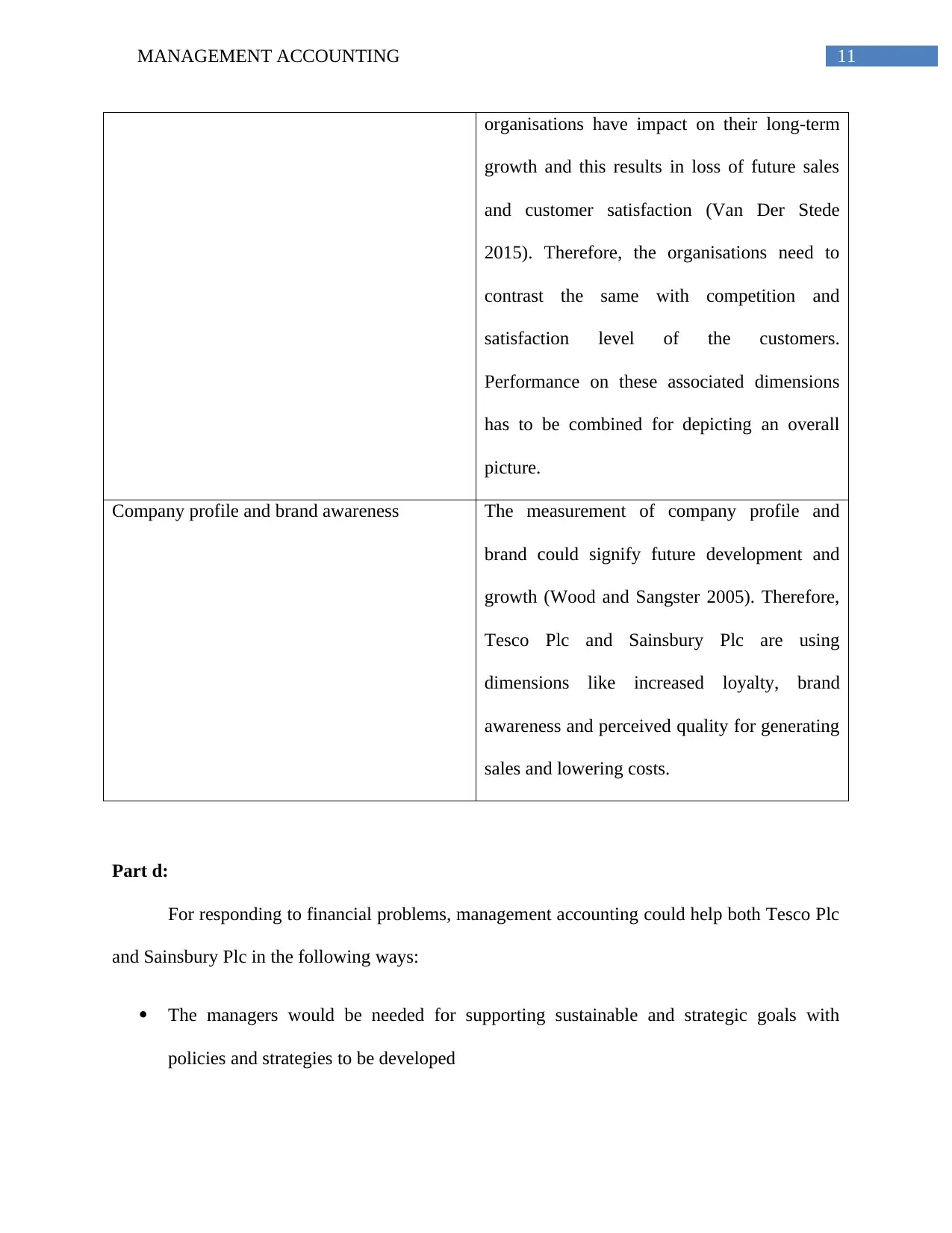
11MANAGEMENT ACCOUNTING
organisations have impact on their long-term
growth and this results in loss of future sales
and customer satisfaction (Van Der Stede
2015). Therefore, the organisations need to
contrast the same with competition and
satisfaction level of the customers.
Performance on these associated dimensions
has to be combined for depicting an overall
picture.
Company profile and brand awareness The measurement of company profile and
brand could signify future development and
growth (Wood and Sangster 2005). Therefore,
Tesco Plc and Sainsbury Plc are using
dimensions like increased loyalty, brand
awareness and perceived quality for generating
sales and lowering costs.
Part d:
For responding to financial problems, management accounting could help both Tesco Plc
and Sainsbury Plc in the following ways:
The managers would be needed for supporting sustainable and strategic goals with
policies and strategies to be developed
organisations have impact on their long-term
growth and this results in loss of future sales
and customer satisfaction (Van Der Stede
2015). Therefore, the organisations need to
contrast the same with competition and
satisfaction level of the customers.
Performance on these associated dimensions
has to be combined for depicting an overall
picture.
Company profile and brand awareness The measurement of company profile and
brand could signify future development and
growth (Wood and Sangster 2005). Therefore,
Tesco Plc and Sainsbury Plc are using
dimensions like increased loyalty, brand
awareness and perceived quality for generating
sales and lowering costs.
Part d:
For responding to financial problems, management accounting could help both Tesco Plc
and Sainsbury Plc in the following ways:
The managers would be needed for supporting sustainable and strategic goals with
policies and strategies to be developed
⊘ This is a preview!⊘
Do you want full access?
Subscribe today to unlock all pages.

Trusted by 1+ million students worldwide
1 out of 16
Related Documents
Your All-in-One AI-Powered Toolkit for Academic Success.
+13062052269
info@desklib.com
Available 24*7 on WhatsApp / Email
![[object Object]](/_next/static/media/star-bottom.7253800d.svg)
Unlock your academic potential
Copyright © 2020–2025 A2Z Services. All Rights Reserved. Developed and managed by ZUCOL.




